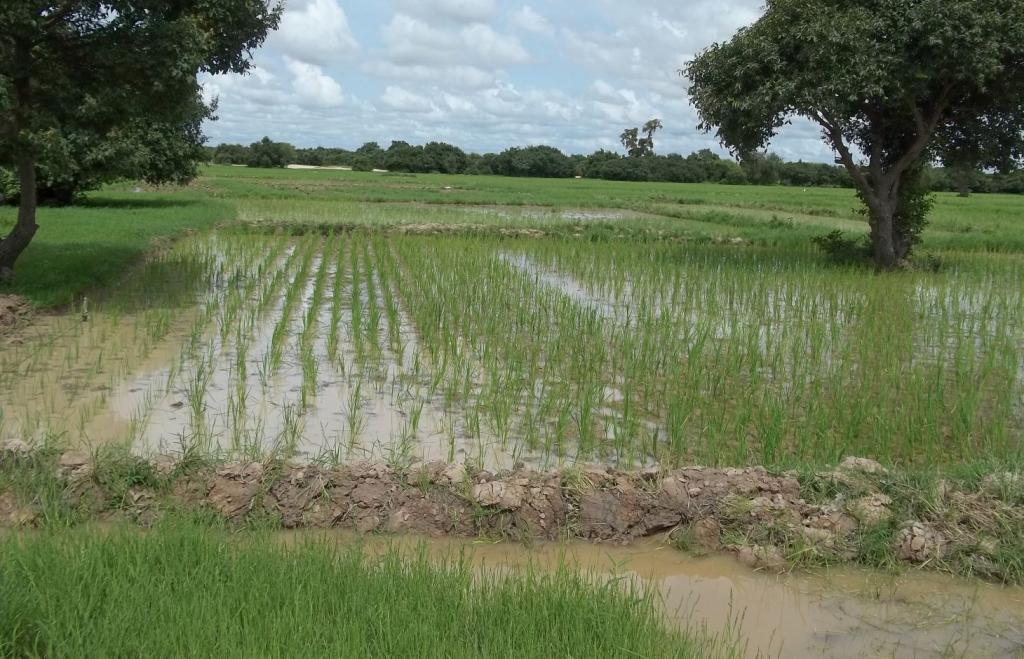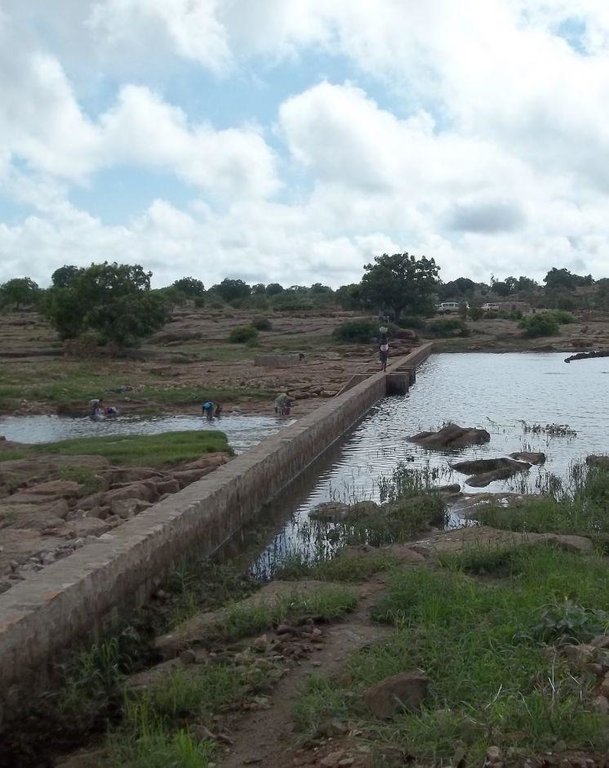Developing lands adjacent to small-scale irrigation schemes [马里]
- 创建:
- 更新:
- 编制者: Dieter Nill
- 编辑者: –
- 审查者: Laura Ebneter
Mise en valeur de terres adjacentes à la petite irrigation (French)
approaches_2514 - 马里
查看章节
全部展开 全部收起1. 一般信息
1.2 参与方法评估和文件编制的资源人员和机构的联系方式
SLM专业人员:
Dako Jean Parfait
parfaitdako@yahoo.fr
Direction Nationale de l'Agriculture (DNA)
马里
有助于对方法进行记录/评估的机构名称(如相关)
Direction Nationale de l'Agriculture (DNA) - 马里有助于对方法进行记录/评估的机构名称(如相关)
Deutsche Gesellschaft für Internationale Zusammenarbeit (GIZ) GmbH (GIZ) - 德国1.3 关于使用通过WOCAT记录的数据的条件
(现场)数据是什么时候汇编的?:
01/07/2012
编制者和关键资源人员接受有关使用通过WOCAT记录数据的条件。:
是
2. SLM方法的描述
2.1 该方法的简要说明
Ensure the optimum exploitation of flood recession areas around bodies of water in order to improve agricultural production.
2.2 该方法的详细说明
该方法的详细说明:
The objective of this practice is to ensure the optimum exploitation of flood recession areas around bodies of water in order to improve agricultural production. This involves using water wisely by choosing suitable crops for the strips of adjacent land.
With this method, it is possible to manage the different water levels around reservoirs. Crops are chosen according to the water level: floating rice for areas where water is deeper; erect rice for moderate depths; and maize, vegetables and trees where surface-water levels are low.
Before the site is developed, farming advisors from the National Directorate of Agriculture (DNA) provide training to growers on benefits, constraints, possible land uses and the operating plan for the land. While the scheme is being built, rural engineering agents inform growers about how to maintain the scheme. Once the scheme is built, the rural engineering service provides training to growers and farming advisors on how to operate the scheme. A village committee is set up to manage the scheme. Committee members must be available and prepared to work in the interest of the community. Crop layouts and land allocations are formalised in an operating plan created consensually with growers. Areas around the reservoir are catalogued and the village council – with the support of technical experts (farming and rural engineering) – then allocate the lands in accordance with the three sections established: the deep section, the moderate-level section and the low-water section. Operation: In collaboration with the growers, the farming advisors set the farming calendar (ploughing, sowing, weeding, etc.) for each of the three sections around the reservoir. The calendar must be adhered to by everyone concerned. The advisors carry out regular monitoring of farming activities and propose corrective measures. The scheme management committee monitors the provision of agricultural inputs, compliance with the operating plan, adherence to the agricultural calendar and the condition of the scheme, and it undertakes repairs when required.
Three essential success factors for managing a reservoir have been identified: the organisation of growers around the scheme to ensure all aspects (infrastructure, lands, water) are well managed; the maintenance of the scheme and reservoir banks (if the banks degrade, the adjacent land may erode or be lost); adherence to the agricultural calendar, which is key for getting the best results from installations.
Village councils participate in the allocation of land to prevent conflicts and ensure compliance with the conditions of the land allocation and the rules in place for the scheme. The management committee ensures the upkeep of the scheme and the supply of agricultural inputs through bulk purchasing. Growers must comply with the agricultural calendar and correctly apply the recommended cropping techniques. Farming advisors train growers, monitor the farming of the site and recommend high-performing and suitable varieties. Rural engineering experts provide training on scheme maintenance, management and monitoring.
2.3 该方法的照片
2.5 采用该方法的国家/地区/地点
国家:
马里
区域/州/省:
Mali
有关地点的进一步说明:
Sikasso, Kita, Kati
Map
×2.6 该方法的开始和终止日期
注明开始年份:
2004
2.7 方法的类型
- 基于项目/方案
2.8 该方法的主要目的/目标
The objective of this practice is to ensure the optimum exploitation of flood recession areas around bodies of water in order to improve agricultural production. This involves using water wisely by choosing suitable crops for the strips of adjacent land.
The SLM Approach addressed the following problems: manage the different water levels around reservoirs
2.9 推动或妨碍实施本办法所适用的技术的条件
了解SLM,获得技术支持
- 阻碍
low exploitation of flood recession areas around bodies of water
Treatment through the SLM Approach: With this method, it is possible to manage the different water levels around reservoirs. Crops are chosen according to the water level: floating rice for areas where water is deeper; erect rice for moderate depths; and maize, vegetables and trees where surface-water levels are low.
3. 相关利益相关者的参与和角色
3.1 该方法涉及的利益相关者及其职责
- 当地土地使用者/当地社区
- SLM专家/农业顾问
- 地方政府
- 国家政府(规划者、决策者)
- 国际组织
3.2 当地土地使用者/当地社区参与该方法的不同阶段
| 当地土地使用者/当地社区的参与 | 指定参与人员并描述活动 | |
|---|---|---|
| 启动/动机 | 被动 | |
| 计划 | 被动 | |
| 实施 | 互动 | |
| 监测/评估 | 被动 | |
| Research | 被动 |
3.4 有关SLM技术选择的决策
具体说明谁有权决定选择要实施的技术:
- 主要是SLM专家,咨询土地使用者之后
解释:
Decisions on the method of implementing the SLM Technology were made by mainly by SLM specialists with consultation of land users
4. 技术支持、能力建设和知识管理
4.1 能力建设/培训
是否为土地使用者/其他利益相关者提供培训?:
是
明确受训人员:
- 土地使用者
培训形式:
- 在职
- 公开会议
- 课程
涵盖的主题:
Before the site is developed, farming advisors from the National Directorate of Agriculture (DNA) provide training to growers on benefits, constraints, possible land uses and the operating plan for the land. While the scheme is being built, rural engineering agents inform growers about how to maintain the scheme. Once the scheme is built, the rural engineering service provides training to growers and farming advisors on how to operate the scheme.
4.2 咨询服务
土地使用者有权使用咨询服务吗?:
是
指明是否提供了咨询服务:
- 在土地使用者的土地上
说明/注释:
Key elements: farming advisors from the National Directorate of Agriculture (DNA) provide training to growers on benefits, constraints, possible land uses and the operating plan for the land, rural engineering agents inform growers about how to maintain the scheme, rural engineering service provides training to growers and farming advisors on how to operate the scheme
4.3 机构强化(组织发展)
是否通过这种方法建立或加强了机构?:
- 是,适度
具体说明机构的强化或建立程度:
- 本地
具体说明支持类型:
- 财务
- 能力建设/培训
- 设备
4.4 监测和评估
监测和评估是该方法的一部分吗?:
是
注释:
technical aspects were regular monitored by project staff through observations
economic / production aspects were regular monitored by project staff through observations
management of Approach aspects were regular monitored by project staff through observations
provision of agricultural inputs aspects were regular monitored by project staff through measurements
farming of the site aspects were regular monitored by project staff through observations
There were no changes in the Approach as a result of monitoring and evaluation
There were no changes in the Technology as a result of monitoring and evaluation
4.5 研究
研究是该方法的一部分吗?
是
明确话题:
- 社会学
- 经济/市场营销
- 生态学
- 技术
5. 融资和外部物质支持
5.2 为土地使用者提供财政/物质支援
土地使用者是否获得实施该技术的财政/物质支持?:
是
5.3 对特定投入的补贴(包括劳动力)
- 设备
| 具体说明哪些投入得到了补贴 | 程度如何 | 对补贴做出具体说明 |
|---|---|---|
| 机械 | 充分融资 | |
| 工具 | 充分融资 | |
- 其它
| 其它(具体说明) | 程度如何 | 对补贴做出具体说明 |
|---|---|---|
| training | 充分融资 |
如果土地使用者的劳动力是一项重要的投入,那么是不是:
- 自愿
6. 影响分析和结论性陈述
6.1 方法的影响
该方法是否帮助土地使用者实施和维护SLM技术?:
- 否
- 是,很少
- 是,中等
- 是,支持力度很大
With this method, it is possible to manage the different water levels around reservoirs. Crops are chosen according to the water level: floating rice for areas where water is deeper; erect rice for moderate depths; and maize, vegetables and trees where surface-water levels are low.
该方法是否有助于社会和经济弱势群体?:
- 否
- 是,很少
- 是,中等
- 是,支持力度很大
Did other land users / projects adopt the Approach?
- 否
- 是,很少
- 是,中等
- 是,支持力度很大
The practice has been applied in Sikasso Circle (two communes), Kita Circle (two communes) and Kati Circle (one commune). The practice has been applied in over 35 schemes for around 10 years.
Did the Approach lead to improved livelihoods / human well-being?
- 否
- 是,很少
- 是,中等
- 是,支持力度很大
optimum exploitation of flood recession areas around bodies of water in order to improve agricultural production
Did the Approach help to alleviate poverty?
- 否
- 是,很少
- 是,中等
- 是,支持力度很大
6.2 土地使用者实施SLM的主要动机
- 增加生产
- 增加利润(能力),提高成本效益比
6.3 方法活动的可持续性
土地使用者能否维持通过该方法实施的措施(无外部支持的情况下)?:
- 是
6.4 该方法的长处/优点
| 编制者或其他关键资源人员认为的长处/优势/机会 |
|---|
| Once good land and water management are assured, the first notable effect is the safeguarding of agricultural activity. As a result of this, agricultural production increases in the villages. (How to sustain/ enhance this strength: When growers demonstrate a strong desire to develop the scheme in this way, its sustainability is guaranteed. Farming advisors are on hand to support growers in the sound exploitation of lands adjacent to reservoirs.) |
| optimum exploitation of flood recession areas around bodies of water in order to improve agricultural production |
| With this method, it is possible to manage the different water levels around reservoirs. Crops are chosen according to the water level. |
7. 参考和链接
7.1 方法/信息来源
- 实地考察、实地调查
- 与土地使用者的访谈
7.2 参考可用出版物
标题、作者、年份、ISBN:
Manual of Good Practices in Small Scale Irrigation in the Sahel. Experiences from Mali. Published by GIZ in 2014.
可以从哪里获得?成本如何?
http://star-www.giz.de/starweb/giz/pub/servlet.starweb
标题、作者、年份、ISBN:
Exploitation des petits aménagements hydro-agricoles [Farming small-scale irrigation schemes] (DNA 2011)
链接和模块
全部展开 全部收起链接
无链接
模块
无模块





